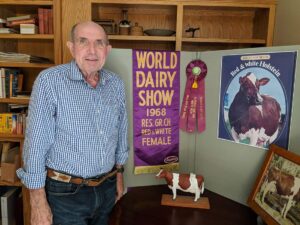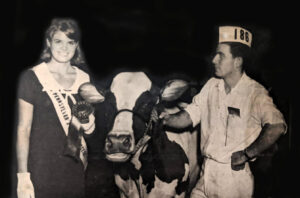 Owatonna Peoples Press, Faribault Daily News and Waseca County News (Saturday May 15, 2021)Ever since Ronald Eustice owned his first dairy animal — at just 15 months old — he has been involved the cattle industry in some way, shape or form.
Owatonna Peoples Press, Faribault Daily News and Waseca County News (Saturday May 15, 2021)Ever since Ronald Eustice owned his first dairy animal — at just 15 months old — he has been involved the cattle industry in some way, shape or form.
At the time, Eustice’s parents were short of money and cashed a $50 savings bond given to Eustice by his great-grandfather. They purchased a Brown Swiss cow with the money because they thought he needed a cow more than he needed the money. Little did they know, that was just the beginning of the accomplishments/achievements that would follow in the next seven decades.
Eustice, who currently splits his time between Tucson, Arizona and Burnsville, Minnesota with his wife Margaret, was a 1963 graduate of Owatonna High School and dedicated more than 50 years of service to the dairy and beef industries. Since stepping down as Minnesota Beef Council Executive Director in 2012, he has written about a half dozen books on various agriculture and cattle topics, building off ideas/experiences from his own personal farm background and his professional career.
Born in Waseca, he grew up in Deerfield Township in Steele County and attended a one-room country school through eighth grade. Eustice says his early involvement in 4-H activities helped create a continuing interest in livestock, participating in dairy, swine, lamb and junior leadership projects. While in high school, Eustice participated in FFA and was a member of the Minnesota State Fair Champion Dairy Judging team.
While still in high school, Eustice worked three summers at Mor-Ayr Farm, Red Wing. Mor-Ayr Farm, Eustice said, was owned by Dr. R.B. Graves and by 1963 was managed by Jerry Strandlund. The herd was shown at county fairs in Minnesota like Rice, Steele and Le Sueur, the Minnesota State Fair, National Dairy Cattle Congress and the International Livestock Exposition in Chicago.
Eustice worked under Klussendorf trophy award winner, Arthur Clark, the summer of 1964 at Meredith Farm in Topsfield, Massachusetts. The following year, he was a summer intern at E-L-V Apache Ranch in Lapeer, Michigan.
 Eustice earned a Bachelor of Arts degree from the University of Minnesota in 1968 and later received a Master of Business Administration degree. His working career began as a marketing specialist with Successful Farming magazine in Des Moines. Wanting to get a little closer to the cattle business, Eustice reached out to Carnation Genetics in Washington for a job opportunity. He then began a seven-year association with Carnation, his first assignment in Mexico where he directed sales and taught A.I. classes in the Spanish language for Carnation de Mexico. Rising through the ranks of the company as director of international marketing and general manager, Eustice would ultimately become general manager.
Eustice earned a Bachelor of Arts degree from the University of Minnesota in 1968 and later received a Master of Business Administration degree. His working career began as a marketing specialist with Successful Farming magazine in Des Moines. Wanting to get a little closer to the cattle business, Eustice reached out to Carnation Genetics in Washington for a job opportunity. He then began a seven-year association with Carnation, his first assignment in Mexico where he directed sales and taught A.I. classes in the Spanish language for Carnation de Mexico. Rising through the ranks of the company as director of international marketing and general manager, Eustice would ultimately become general manager.
Building from experience
Through both his personal interests and job experiences, Eustice authored two comprehensive books on Red & White Holsteins, the polled gene in dairy cattle and the development of North America’s cattle industry from the days of the Spanish explorers through the cattle drives of the mid-19th century, among others.
“Gentlemen Farmers: Farms & Ranches of The Rich & Famous,” his most recent book, is the story of wealthy individuals who owned farms and cattle during the 1900s. One of the farms featured in this book, Eustice said, was owned by Herbert Gilkey, a wealthy lumberman who had offices in Minneapolis but had a fancy farm west of Owatonna. Eustice said this volume also includes stories about five medical doctors from the Mayo Clinic who owned farms and had purebred Holsteins near Rochester and one of the those doctors was Dr. Charles Mayo (one of the original Mayos).
The next volume in the Gentlemen Farmers series, Eustice says, will include the story of the Minnesota Holstein Company at Austin that was one of the premier Holstein herds of the 1920s. The partner with the money was a Hormel executive named Alpha Eberhard who lost his job at Hormel when one of his employees Cy Thompson swindled $1 million from the Hormel bank account. Thompson used the money to buy farms including one called Oak Dale Farm near Blooming Prairie. He was a gentleman farmer with purebred Holsteins and fancy chickens and spent a few years in prison at Stillwater.
Each piece of information Eustice includes in his books is highly researched and documented. He said he strives to find as much background on everybody as he can, and works very closely with historical societies and sites like Ancestry.com.
“I make sure I have accurate information and am able to find out as much as I can about the individuals and where they came from,” Eustice added.
He continues to be inspired to write and share his and others’ stories for not only personal satisfaction and enjoyment, but also through his passion for research, writing and laying out graphics.
Through personal experiences from his extensive involvement in the cattle industry, Eustice urges young writers/cattle enthusiasts to focus on two elements: networking and finding mentors.
“Every opportunity leads to another opportunity,” Eustice said. “I could never have accomplished what I had without a lot of support from friends and family.”
Eustice also encourages all to keep looking for the right opportunity and to look at a setback as an opportunity to build on, instead of as a failure.
Through fulfilling a plethora of accomplishments and achievements, Eustice feels very fortunate to have grown up in southern Minnesota, especially in an area where agriculture is seen as important.
“It’s a beautiful place to grow up, there’s wonderful schools, rural youth activities, whether it’s Rice, Steele or Waseca,” Eustice said. “We’re very, very fortunate, especially as an area that’s very advanced from an ag standpoint. We’re proud to grow up on a farm and are very fortunate to have that as a background.”
